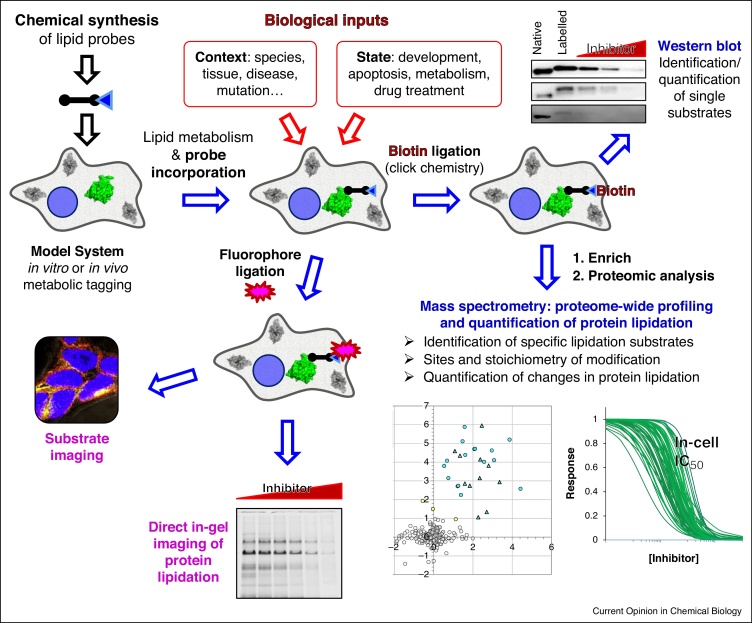
- Home
- PTMs Proteomics
- Protein Lipidation Analysis Service
Protein lipidation stands as a pivotal PTM that involves the covalent attachment of lipid moieties to proteins. This modification enables proteins to interact directly with cell membranes, profoundly influencing their function, localization, and activity. Protein lipidation plays a ubiquitous role in all forms of life, with its most sophisticated manifestations observed in eukaryotes, where it regulates vesicular trafficking pathways and membrane-bound signaling platforms.
 A common workflow can be used to address each of the common classes of lipidationProtein
A common workflow can be used to address each of the common classes of lipidationProtein
| Protein Lipidation Type | Description | What Creative Proteomics Can Do |
|---|---|---|
| N-Myristoylation | N-Myristoylation represents a extensively researched form of protein N-acylation, involving the covalent attachment of myristic acid (a C14 fatty acid) to the N-terminal glycine of substrate proteins. | Creative Proteomics specializes in the detection of N-Myristoylation, demonstrating exceptional expertise in the precise identification of this modification type. We provide in-depth insights into its functional roles across various biological processes. Furthermore, our research in N-Myristoylation opens up new avenues for potential drug targets, particularly in the context of infectious diseases. |
| N-Acylation at N-Terminus and Lysine | Protein N-acylation is not limited to the N-terminus but can also occur at lysine residues, as exemplified by the N-terminal cysteine acylation of hedgehog (Hh) proteins. | Creative Proteomics offers robust chemical proteomics tools for the accurate and comprehensive detection of these modification events. |
| S-Acylation (S-Palmitoylation) | S-Acylation, commonly known as S-palmitoylation, involves the formation of thioester linkages at cysteine residues, and it is tightly regulated by protein acyltransferases (PATs). | Creative Proteomics is at the forefront of S-Acylation detection and analysis, with our cutting-edge techniques and methods enabling precise identification of S-acylation modifications. We empower researchers to gain detailed insights into the impact of S-Acylation on various cellular processes. |
| S-Prenylation | Protein S-prenylation entails the attachment of farnesyl or geranylgeranyl isoprenoids to cysteine residues located in close proximity to the C-terminus of target proteins. | Creative Proteomics boasts significant expertise in S-Acylation detection and analysis. Our advanced techniques and methods allow for the precise identification of S-acylation modifications, enabling researchers to delve deeper into their influence on a wide array of cellular processes. |
| GPI Anchored Proteins | Glycosylphosphatidylinositol (GPI)-anchored proteins are essential constituents of cell surfaces, playing critical roles in extracellular communication. | Creative Proteomics offers innovative metabolic chemical tagging methodologies tailored for the selective and quantitative analysis of GPI-anchored proteins. Our solutions facilitate a comprehensive understanding of their functions and potential as promising therapeutic targets. |
| O-Cholesterylation | Protein cholesterylation represents a unique modification primarily observed within the hedgehog (Hh) family of secreted proteins. This process involves post-translational autocleavage of the C-terminal domain concomitant with O-cholesterylation. | Creative Proteomics provides highly efficient chemical tools designed to investigate this distinctive modification. Our resources enhance the comprehension of its significance in the context of diseases and tissue repair. |
In the realm of proteomics services, Creative Proteomics stands as a prominent authority, particularly in the vanguard of protein lipidation analysis. Our proficiency in leveraging mass spectrometry-based methodologies, in conjunction with pioneering approaches to sample preparation and data analysis, equips investigators with the means to comprehensively navigate the intricate domain of protein lipidation.
One of our specialized offerings encompasses lipid type profiling services, a capability that enables the nuanced discrimination among distinct lipid modifications, including myristoylation, palmitoylation, prenylation, and various others. The insights derived from this service furnish invaluable perspectives into the intricate lipidation patterns evident within your samples.
Leveraging cutting-edge mass spectrometry instrumentation and sophisticated data analysis tools, we facilitate the precise identification of lipidation events at specific amino acid sites. This precision significantly enhances your comprehension of the functional implications associated with protein lipidation.
Creative Proteomics extends its purview to encompass quantitative analysis of protein lipidation, offering a comprehensive suite of tools for conducting comparative investigations. This capability not only facilitates the discernment of quantitative differences but also enables in-depth exploration of the regulatory mechanisms governing alterations in lipidation patterns.
Unprecedented Insight
Our service unlocks the full scope of protein lipidation in vivo, allowing for the discovery of novel lipidated proteins and a deeper understanding of their functions.
Target-Specific Analysis
With the ability to pinpoint the exact sites of lipidation, our service enables precise characterization of lipidated proteins and their role in cellular processes.
Disease Relevance
By quantifying changes in protein lipidation in response to genetic mutations, diseases, or drug treatments, we offer valuable insights into disease mechanisms and potential therapeutic targets.
Comprehensive Proteome Coverage
Our high-throughput approach ensures comprehensive proteome coverage, providing a holistic view of lipidation events across all proteins.
Our products and services are for research use only.